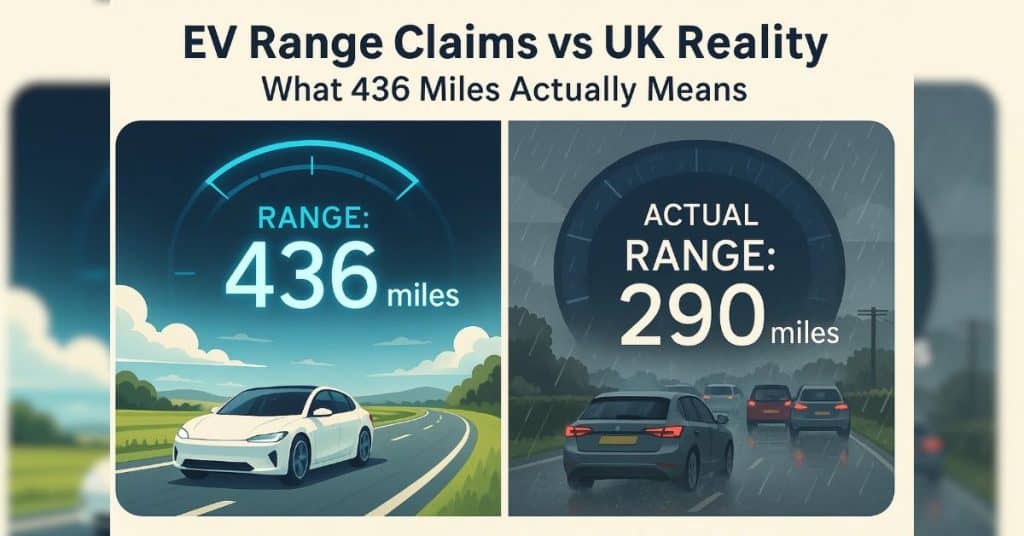EV Range Claims vs UK Reality: What 436 Miles Actually Means
Written & Researched by Des Dreckett

Every major EV manufacturer uses WLTP range figures that sound impressive on paper. Tesla’s Model 3 Long Range claims 436 miles, the Cupra Born VZ promises 366 miles, and the Mercedes EQS boasts 481 miles. But UK drivers consistently get 20-45% less than these official figures.
Here’s why this gap exists across the entire industry – and what it means for your wallet.
THE INDUSTRY STANDARD CLAIMS
All EV manufacturers advertise ranges using WLTP (Worldwide Harmonised Light Vehicle Test Procedure) figures:
- Tesla Model 3 Long Range: 436 miles
- Cupra Born VZ: 366 miles
- Mercedes EQS: 481 miles
- Renault Megane E-Tech: 280 miles
These aren’t Tesla-specific claims – they’re the industry standard way of measuring and marketing EV range across Europe.
THE UK REALITY CHECK
Real-world UK driving consistently delivers significantly less range across all brands:
- WLTP claim: 436 miles
- UK reality: 250-350 miles typical, 200 miles in winter
- WLTP claim: 366 miles
- UK reality: 294 miles summer, 200-250 miles winter
- WLTP claim: 280 miles
- UK reality: 180-220 miles in mixed conditions
The Energy Saving Trust confirms most EVs achieve around 220 miles real-world range, regardless of manufacturer or price point.
WHY EVERY EV FALLS SHORT
This isn’t about one manufacturer being dishonest – it’s about how WLTP testing works versus real UK driving:
Laboratory Perfect Conditions WLTP tests happen at exactly 23°C with no heating, air conditioning, or real-world variables. Every manufacturer benefits from these unrealistic conditions.
UK Climate Reality British weather means you’re running heating systems 6+ months per year. Cold temperatures reduce all lithium-ion batteries by 10-30%, affecting every EV brand equally.
Real Driving Patterns WLTP uses gentle acceleration and modest speeds. UK motorway driving at 70mph+ increases energy consumption significantly across all electric vehicles.
Industry-Wide Issue This isn’t Tesla being misleading – BMW, Audi, Volkswagen, and every other manufacturer show the same 20-45% gap between WLTP claims and UK reality.
WHAT THIS MEANS FOR YOUR PURCHASE
Understanding this industry-wide gap helps you make better EV decisions:
Realistic Trip Planning A car claiming 300 miles WLTP range gives you roughly 200-240 miles real-world UK driving. Plan charging stops accordingly.
Compare Like-for-Like Since all manufacturers use WLTP, you can still compare EVs relatively – just reduce all claimed ranges by 25-30% for realistic expectations.
Budget for Reality That 400-mile journey might need two charging stops instead of one, especially in winter. Factor motorway charging costs (27-79p/kWh) into your calculations.
HOW TO CHOOSE WISELY
Rule of Thumb: Reduce All Claims by 30% Whatever WLTP range any manufacturer claims, expect 70% of that figure for realistic UK driving. This applies to Tesla, BMW, Volkswagen – everyone.
Focus on Efficiency, Not Just Range Look for cars with good miles per kWh efficiency ratings. These perform better in real-world conditions regardless of battery size.
Consider Your Actual Needs Most UK drivers cover under 40 miles daily. Even a “short range” EV with 200 miles real-world capability handles 99% of journeys with overnight home charging.
Test Drive in UK Conditions Drive any EV you’re considering in typical British weather with heating/cooling on. Every brand will fall short of lab claims, but some handle real conditions better.
THE BOTTOM LINE
WLTP range claims create unrealistic expectations across the entire EV industry. Tesla’s 436-mile Model 3, BMW’s iX range claims, and Volkswagen’s ID.4 figures all suffer the same 20-45% real-world reduction.
This isn’t about manufacturers being dishonest – it’s about laboratory test conditions that don’t match British roads and weather. Understanding this helps you choose the right EV with realistic expectations.
We may earn a commission if you use this link, but our recommendations remain independent. We help you understand real EV performance across all brands, not marketing figures.
Smart EV buying means planning for UK reality, not European test lab perfection.
Every EV manufacturer shows this gap. The key is knowing what to expect before you buy.
